
Shantiniketan is a neighbourhood of Bolpur town in the Bolpur subdivision of Birbhum district in West Bengal, India, approximately 152 km north of Kolkata. It was established by Maharshi Devendranath Tagore, and later expanded by his son, Rabindranath Tagore whose vision became what is now a university town with the creation of Visva-Bharati.

The National Gallery of Modern Art (NGMA) is the premier art gallery under Ministry of Culture, Government of India. The main museum at Jaipur House in New Delhi was established on 29 March 1954 by the Government of India, with subsequent branches at Mumbai and Bangalore. Its collection of more than 1700 works by 2000 plus artists includes artists such as Thomas Daniell, Raja Ravi Verma, Abanindranath Tagore, Rabindranath Tagore, Gaganendranath Tagore, Nandalal Bose, Jamini Roy, Amrita Sher-Gil as well as foreign artists. Some of the oldest works preserved here date back to 1857. With 12,000 square meters of exhibition space, the Delhi branch is one of the world's largest modern art museums.

The Bengal School of Art, commonly referred as Bengal School, was an art movement and a style of Indian painting that originated in Bengal, primarily Kolkata and Shantiniketan, and flourished throughout the Indian subcontinent, during the British Raj in the early 20th century. Also known as 'Indian style of painting' in its early days, it was associated with Indian nationalism (swadeshi) and led by Abanindranath Tagore (1871–1951), but was also being promoted and supported by British arts administrators like E. B. Havell, the principal of the Government College of Art and Craft, Kolkata from 1896; eventually it led to the development of the modern Indian painting.
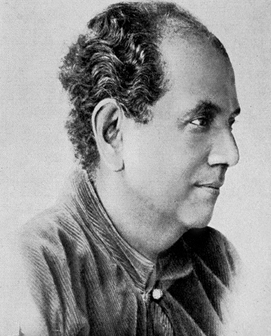
Abanindranath Tagore was the principal artist and creator of the "Indian Society of Oriental Art". He was also the first major exponent of Swadeshi values in Indian art. He founded the influential Bengal school of art, which led to the development of modern Indian painting. He was also a noted writer, particularly for children. Popularly known as 'Aban Thakur', his books Rajkahini, Buro Angla, Nalak, and Khirer Putul were landmarks in Bengali language children's literature and art.

Nandalal Bose was one of the pioneers of modern Indian art and a key figure of Contextual Modernism.
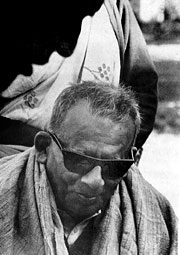
Benode Behari Mukherjee was an Indian artist from West Bengal state. Mukherjee was one of the pioneers of Indian modern art and a key figure of Contextual Modernism. He was one of the earliest artists in modern India to take up to murals as a mode of artistic expression. All his murals depict a subtle understanding of environmental through pioneering architectural nuances.

Achutan Ramachandran Nair, popularly known as A. Ramachandran, is an Indian painter, born in 1935 in Attingal, Kerala. In 2002, he was elected a Fellow of the Lalit Kala Akademi and in 2005, he was awarded the Padma Bhushan, India's third highest civilian honour, for outstanding service to the nation. In 2013, he was conferred with an honorary doctorate by Mahatma Gandhi University, Kerala.

Ramkinkar Baij was an Indian sculptor and painter, one of the pioneers of modern Indian sculpture and a key figure of Contextual Modernism.
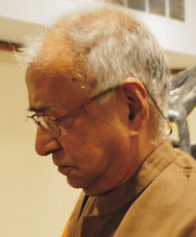
Kalpathi Ganpathi "K.G." Subramanyan was an Indian artist. He was awarded the Padma Vibhushan in 2012.

The modern Indian art movement in Indian painting is considered to have begun in Calcutta in the late nineteenth century. The old traditions of painting had more or less died out in Bengal and new schools of art were started by the British. Initially, protagonists of Indian art such as Raja Ravi Varma drew on Western traditions and techniques including oil paint and easel painting. A reaction to the Western influence led to a revival in primitivism, called as the Bengal school of art, which drew from the rich cultural heritage of India. It was succeeded by the Santiniketan school, led by Rabindranath Tagore's harking back to idyllic rural folk and rural life. Despite its country-wide influence in the early years, the importance of the school declined by the 'forties' and now it is as good as dead.
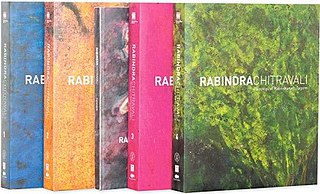
Rabindra Chitravali is a 2011 four-volume set of books by art historian R. Siva Kumar that contains paintings of Rabindranth Tagore. These include about 1700 paintings in the Rabindra Bhavana and Kala Bhavana collections of Visva-Bharati, Santiniketan; and more than 300 paintings in the collection of the National Gallery of Modern Art and the collections at Rabindra Bharati University, Kolkata; National Gallery of Modern Art, New Delhi and Bangalore; and Indian Museum, Kolkata.

Kala Bhavana is the fine arts faculty of Visva-Bharati University, in Shantiniketan, India. It is an institution of education and research in visual arts, founded in 1919, it was established by Nobel laureate Rabindranath Tagore.
Paintings of Abanindranath Tagore is a book on Abanindranath Tagore's paintings by art historian R. Siva Kumar. It is widely considered as a landmark book in the Indian art scene that brings together a large corpus of Abanindranath's work for the first time. It fulfils a glaring lacuna in the picture of this master of modern Indian art.
Santiniketan: The Making of a Contextual Modernism was an exhibition curated by R. Siva Kumar at the National Gallery of Modern Art in 1997, on the occasion of the 50th anniversary of India's Independence.
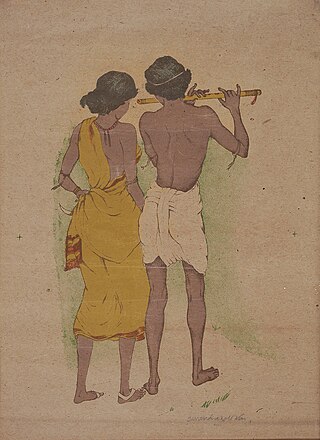
Surendranath Kar was an Indian artist and architect, known for amalgamating the Indian architectural style with western and eastern styles of architecture. Born in 1892 in British India, Kar did his primary learning of art under his cousin, renowned Bengali painter, Nandalal Bose, and Abanindranath Tagore, the nephew of Nobel Laureate, Rabindranath Tagore. Later, he joined Vichitra Club, founded by the Tagore family, as a teacher of art. In 1917, when Tagore set up Brahmacharyasrama, the precursor of later day Shantiniketan, he joined the institution and worked as an art teacher. Two years later, he moved to Kala Bhavana of Tagore as a faculty member.
Chitranibha Chowdhury was a twentieth-century Indian artist, a member of the Bengal School of Art, and one of the first female painters in Bengal. She created over a thousand artworks, including landscapes, still lifes, decorative art, murals, and portraits. She was a student of Nandalal Bose and was the first female painting teacher in Shantiniketan Kolabhaban.Her real name Nibhanani Bose to Chitranibha Bose by Rabindranath Tagore.
The following is a list of notable people associated withVisva- Bharati University and/or Santiniketan, a neighbourhood in Bolpur city in West Bengal, India:
Dinkar Kowshik (1918-2011) was an Indian painter. As principal of Kala Bhavana at Santiniketan, he reshaped it for contemporary art practices.

Bireswar Sen (1897–1974) was an Indian painter, writer, and teacher, who was influenced by the Bengal School of Art and Western modernism, but then later developed a unique visual language of miniatures. He depicted grand landscapes, mostly featuring the Himalayas, on paintings measuring smaller than postcards. Sen was popular and celebrated during his lifetime, but faded from public consciousness after his death.

Jamuna Sen was an Indian artist, known for her design work in a variety of mediums including Batik and Alpona as well as developing, in an Indian context, a variety of traditional crafts from across the world. She was a pioneer in establishing the practice of Batik in India in modern times. Daughter of Nandalal Bose, a central figure in modern Indian art, she was brought up in the artistic and intellectual milieu of Santiniketan and made significant contributions in the field of design.
















